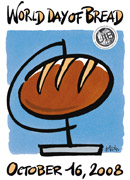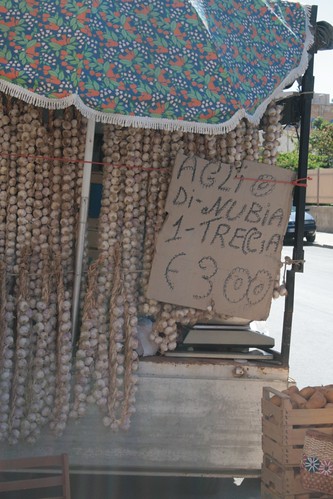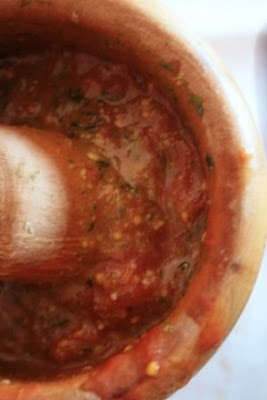
HEY HEY HEY!!!!
Before reading of tossing and tafanari I must explain.
the first night I've tossed only two crusts for photos and dinner and cooked them in my electric pizza oven, the red one proudly called tafanario from my friend Isabella (please, read below!).
But photos during the dinner didn't satisfied me, they were awful and dark.
The others were cooked the next da in the wood oven of my father in law, this is the reason why they are into the jellypan.
My father-in-law didn't allow to cook the pizza in the baking stone so I was obliged to use the jellipan.
and now....my version of a real tossed pizza.
I must apologize...I'm in a terrible late but I'm here for my personal october DB challenge.
As yuo've read in my post title being a pizzaiolo means having a pizzaiolo T-shirt.
white of course, with some advertising on front, possibly with some tomato stains and flour dusted.
And as an actress this is my picture in plastic pose tossing the dough.
It's too small too see me? Reallyyyyyyy?????
:)
Ok I was shaming and laughing whith my husband.
He wasn't able to catch the right moment so I had to toss and toss again spreading dough's pieces around my microscopic kitchen.
In this pic my expression is....I hope for this one!
Sooo I must confess that although we ad a lot of fun tossing the dough the other 4 dough balls were shaped without tossing.
For me and my family pizza is MARGHERITA or NAPOLI only tomato sauce, mozzarella cheese and fresh basil leaves.
This is the classic Margherita, adding salted anchovies it converts into a Napoli.
I know you're wondering what a tafanario is.
Is very difficult to explain, a friend of mine an Italian food blogger Isabella
of deavoring with eyes use this invented term to indicate some cumbersome equipment rarely used and mostly regarding the kitchen.
This is my new tafanario and I'm very proud to introduce you my creature.
A real pizzaiolo oven with a stone too cook perfect pizza like having a wood stove
Rosa is one of my favourite abroad blogger and I was happy for her invitation and sad at the same time for her and for all the DB partecipants.
I can only suppose how difficult is going ahead with a host when your cohost friend passes this is an additional reason to admirate Rosa and I can understand Glenna for her choice.
Sher is not here and can't enjoy her DB challenge with us.
Surely she's reading all the posts and enjoy from the heaven.
Goobye Sherrie.
Obviously all are invited to check others beautiful and luscious pizzas simply scrolling the DB blogroll, you can find it on my sidebar.
RECIPE SOURCE: “The Bread Baker's Apprentice: Mastering The Art of Extraordinary Bread” by Peter Reinhart. Ten Speed Press, Berkeley, CA. Copyright 2001.
ISBN-10: 1-58008-268-8, ISBN-13: 978-158008-268-6.***************
~ BASIC PIZZA DOUGH ~Original recipe taken from “The Bread Baker’s Apprentice” by Peter Reinhart.
Makes 6 pizza crusts (about 9-12 inches/23-30 cm in diameter).
Ingredients:
4 1/2 Cups (20 1/4 ounces/607.5 g) Unbleached high-gluten (%14) bread flour or all purpose flour, chilled (
- FOR GF: 4 ½ cups GF Flour Blend with xanthan gum or 1 cup brown rice flour,
1 cup corn flour,
1 cup oat flour,
1 ½ cup arrowroot, potato or tapioca starch + 2 tsp xanthan or guar gum)
3/4 Tsp Salt - FOR GF use 2 tsp
1 Tsp Instant yeast
1/4 Cup (2 ounces/60g) Olive oil or vegetable oil (both optional, but it’s better with)1
3/4 Cups (14 ounces/420g or 420ml) Water, ice cold (40° F/4.5° C)
1 Tb sugar - FOR GF use agave syrup
Semolina/durum flour or cornmeal for dusting
DAY ONE
Method:
1. Mix together the flour, salt and instant yeast in a big bowl (or in the bowl of your stand mixer).
2. Add the oil, sugar and cold water and mix well (with the help of a large wooden spoon or with the paddle attachment, on low speed) in order to form a sticky ball of dough. On a clean surface, knead for about 5-7 minutes, until the dough is smooth and the ingredients are homogeneously distributed. If it is too wet, add a little flour (not too much, though) and if it is too dry add 1 or 2 teaspoons extra water.
NOTE: If you are using an electric mixer, switch to the dough hook and mix on medium speed for the same amount of time.
The dough should clear the sides of the bowl but stick to the bottom of the bowl.
If the dough is too wet, sprinkle in a little more flour, so that it clears the sides. If, on the contrary, it clears the bottom of the bowl, dribble in a teaspoon or two of cold water.
The finished dough should be springy, elastic, and sticky, not just tacky, and register 50°-55° F/10°-13° C.
Or2. FOR GF: Add the oil, sugar or agave syrup and cold water, then mix well (with the help of a large wooden spoon or with the paddle attachment, on low speed) in order to form a sticky ball of dough.
3. Flour a work surface or counter. Line a jelly pan with baking paper/parchment. Lightly oil the paper.
4. With the help of a metal or plastic dough scraper, cut the dough into 6 equal pieces (or larger if you want to make larger pizzas).
NOTE: To avoid the dough from sticking to the scraper, dip the scraper into water between cuts.
5. Sprinkle some flour over the dough.
Make sure your hands are dry and then flour them. Gently round each piece into a ball.
NOTE: If the dough sticks to your hands, then dip your hands into the flour again.
6. Transfer the dough balls to the lined jelly pan and mist them generously with spray oil. Slip the pan into plastic bag or enclose in plastic food wrap.
7. Put the pan into the refrigerator and let the dough rest overnight or for up to thee days.
NOTE: You can store the dough balls in a zippered freezer bag if you want to save some of the dough for any future baking. In that case, pour some oil (a few tablespooons only) in a medium bowl and dip each dough ball into the oil, so that it is completely covered in oil. Then put each ball into a separate bag. Store the bags in the freezer for no longer than 3 months. The day before you plan to make pizza, remember to transfer the dough balls from the freezer to the refrigerator.
DAY TWO
8. On the day you plan to eat pizza, exactly 2 hours before you make it, remove the desired number of dough balls from the refrigerator.
Dust the counter with flour and spray lightly with oil.
Place the dough balls on a floured surface and sprinkle them with flour.
Dust your hands with flour and delicately press the dough into disks about 1/2 inch/1.3 cm thick and 5 inches/12.7 cm in diameter.
Sprinkle with flour and mist with oil.
Loosely cover the dough rounds with plastic wrap and then allow to rest for 2 hours.
Or8. FOR GF:
On the day you plan to eat pizza, exactly 2 hours before you make it, remove the number of desired dough balls from the refrigerator.
Place on a sheet of parchment paper and sprinkle with a gluten free flour.
Delicately press the dough into disks about ½ inch/1.3 cm thick and 5 inches/12.7 cm in diameter. S
prinkle the dough with flour, mist it again with spray oil.
Lightly cover the dough round with a sheet of parchment paper and allow to rest for 2 hours.
9. At least 45 minutes before making the pizza, place a baking stone on the lower third of the oven. Preheat the oven as hot as possible (500° F/260° C).
NOTE: If you do not have a baking stone, then use the back of a jelly pan. Do not preheat the pan.
10. Generously sprinkle the back of a jelly pan with semolina/durum flour or cornmeal. Flour your hands (palms, backs and knuckles).
Take 1 piece of dough by lifting it with a pastry scraper.
Lay the dough across your fists in a very delicate way and carefully stretch it by bouncing it in a circular motion on your hands, and by giving it a little stretch with each bounce. Once the dough has expanded outward, move to a full toss.
Or10. FOR GF: Press the dough into the shape you want (about 9-12 inches/23-30 cm in diameter - for a 6 ounces/180g piece of dough).
NOTE: Make only one pizza at a time.
During the tossing process, if the dough tends to stick to your hands, lay it down on the floured counter and reflour your hands, then continue the tossing and shaping.
In case you would be having trouble tossing the dough or if the dough never wants to expand and always springs back, let it rest for approximately 5-20 minutes in order for the gluten to relax fully,then try again.You can also resort to using a rolling pin, although it isn’t as effective as the toss method.
11. When the dough has the shape you want (about 9-12 inches/23-30 cm in diameter - for a 6 ounces/180g piece of dough), place it on the back of the jelly pan, making sure there is enough semolina/durum flour or cornmeal to allow it to slide and not stick to the pan.
Or11. FOR GF: Lightly top it with sweet or savory toppings of your choice.
12. Lightly top it with sweet or savory toppings of your choice.
Or12. FOR GF: Place the garnished pizza on the parchment paper onto the stone in the oven or bake directly on the jelly pan. Close the door and bake for about 5-8 minutes.
NOTE: Remember that the best pizzas are topped not too generously. No more than 3 or 4 toppings (including sauce and cheese) are sufficient.
13. Slide the garnished pizza onto the stone in the oven or bake directly on the jelly pan. Close the door and bake for abour 5-8 minutes.
Or13. FOR GF: Follow the notes for this step.
NOTE: After 2 minutes baking, take a peek.
For an even baking, rotate 180°.If the top gets done before the bottom, you will need to move the stone or jelly pane to a lower shelf before the next round.
On the contrary, if the bottom crisps before the cheese caramelizes, then you will need to raise the stone or jelly.
14. Take the pizza out of the oven and transfer it to a cutting board or your plate. In order to allow the cheese to set a little, wait 3-5 minutes before slicing or serving.















































































































































